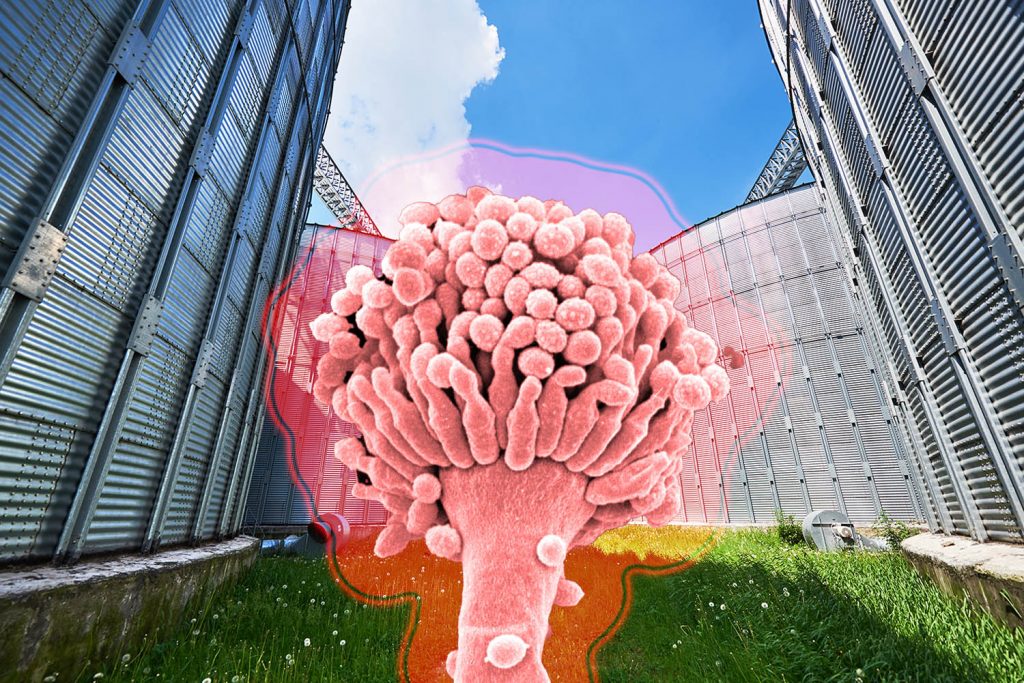11 Dec Real case: spoilage of poultry feed by Aspergillus sp

Poultry feeds are prone to fungal growth during all the stages of the production and distribution process, from the cultivation of the cereal raw materials to the storage in the poultry farm. Although after pelleting there is a significant decrease of mold counts, complete feed can be contaminated by mycotoxin-producing fungi during the transport and the storage in the farm.
When the complete feeds are stored in silos, in the daytime the metal walls become hot and transfer heat to the feed. When the temperature cools down in the evening, condensation appears. Such combination of heat and humidity makes the perfect environment for mold growth, especially when the hygiene of the silo is suboptimal. The growth of molds is accompanied by an increase of the temperature inside the silo (up to 55ºC) and of the feed’s moisture (up to 20%), together with the loss of vitamins and energy content. More information in this article.
Aspergillus sp and Penicillium sp are the main genus of molds involved in recontamination of feeds in during the storage in the farms. Their optimal growth conditions happen at a temperature exceeding 25ºC and a relative humidity higher than 85%.
Contamination by Aspergillus sp used to be restricted to the hottest, most humid areas of the world, but it is increasingly happening elsewhere due to climate change. Several species of Aspergillus sp produce aflatoxins, a group of mycotoxins that damage the digestive, immune and reproductive systems of poultry and swine.
As it is well known, we at PlusVet Animal Health perform analysis services for our customers, and mycotoxin determination is one of them. In the recent weeks, one poultry integrator suspected a problem of mycotoxicosis in one of their farms and sent us samples of their feed. The feed samples had been taken at different steps of their feed storage and the results obtained were as follows:

As it can be seen from the table above, the contamination by total aflatoxins increased with the time the feed had been in the storage and distribution system of the farm, indicating a problem of mold contamination.
We at PlusVet Animal Health always recommend adding a mycotoxin binder like our PlusBind© to the feed, even if the mycotoxin levels after feed manufacturing are lower than the safety recommendations. On the other hand, when sampling the feed in the farms, we recommend to sample at least at the feeder level, to be able to detect the mycotoxins that may have appeared during the storage time in the farm.
Products of choice
PlusBind© is a mixture of carefully selected silicates intended for the prevention of diseases and productivity losses related to the presence of all types of mycotoxins. It is indicated in poultry, pigs, aquaculture and ruminants.
The silicates present in PlusBind© have a highly expandable molecular structure. This characteristic gives the product a wide surface available for the adsorption of mycotoxins and therefore allows a high effectiveness at lower doses (0.5-1 kg per ton of feed).
PlusBind Bio© is a mixture of carefully selected silicates intended for the prevention of diseases and productivity losses related to the presence of all types of mycotoxins. It also contains plant extracts with prebiotic effect.
It is indicated in poultry, pigs and aquaculture.
The silicates present in PlusBind Bio© have a highly expandable molecular structure. This characteristic gives the product a wide surface available for the adsorption of mycotoxins and therefore allows a high effectiveness at lower doses (0.5-1 kg per ton of feed).
Picture of the silo found here. Picture of the mold found here.

Certain health statements may not be applicable in your region.

